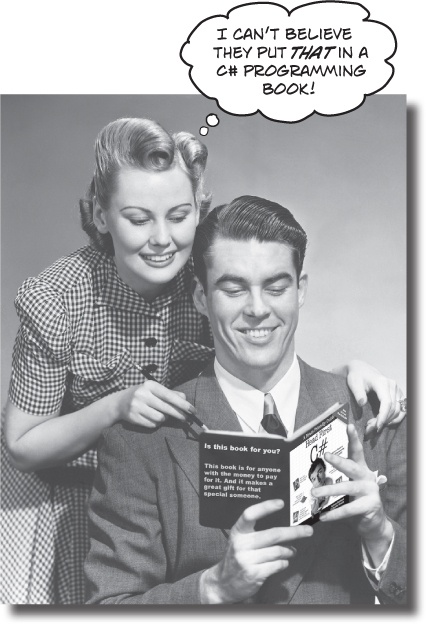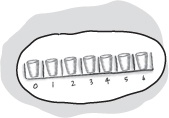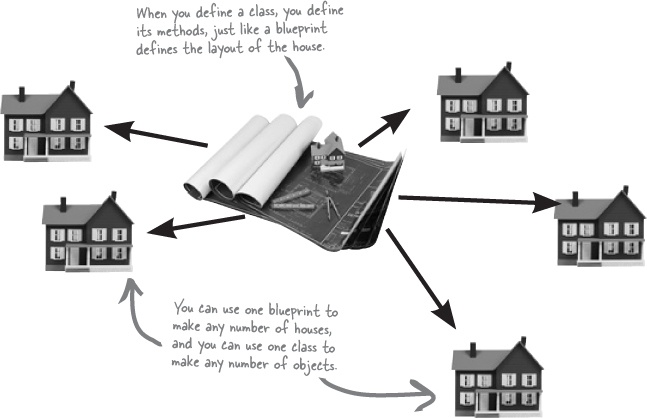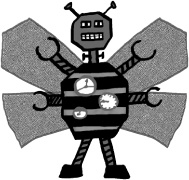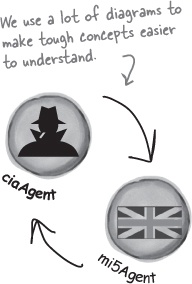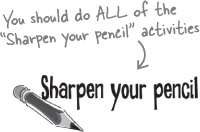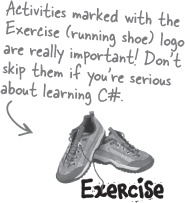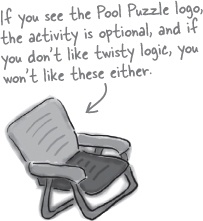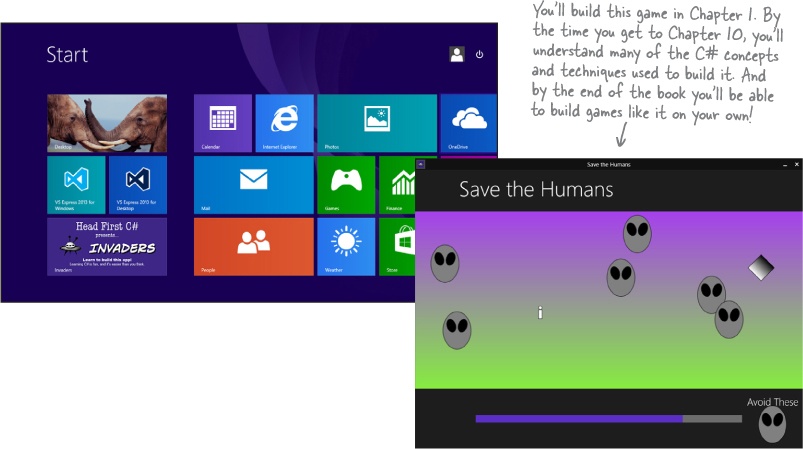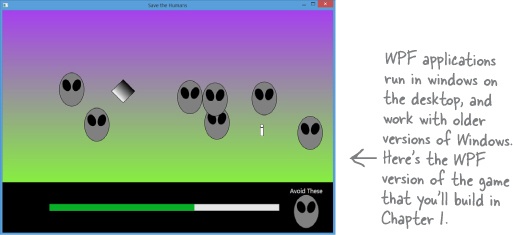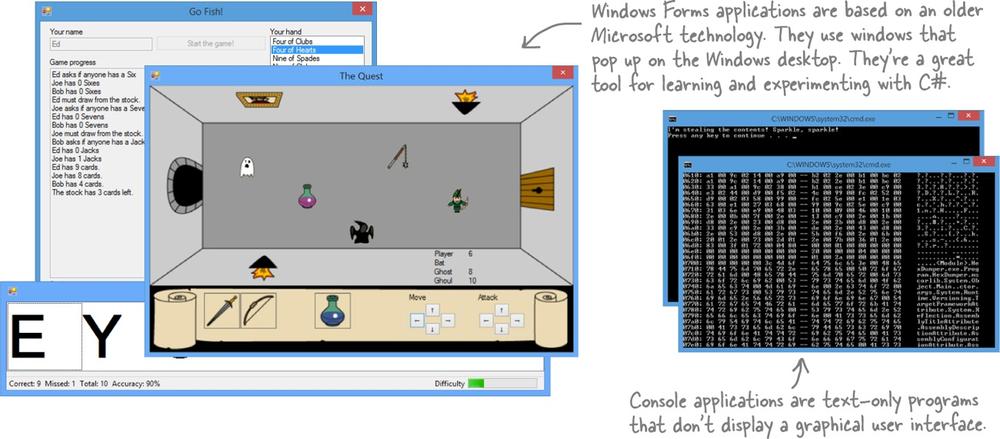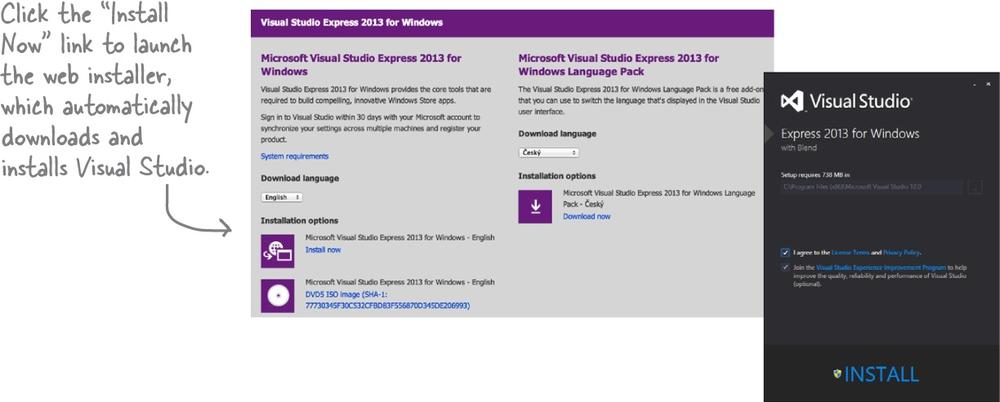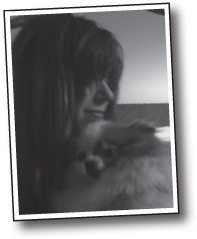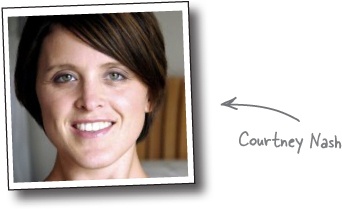How to Use this Book: Intro
Note
In this section, we answer the burning question: “So why DID they put that in a C# programming book?”
Who is this book for?
If you can answer “yes” to all of these:
➊ Do you want to learn C#?
Do you know another programming language, and now you need to ramp up on C#?
➋ Do you like to tinker—do you learn by doing, rather than just reading?
Are you already a good C# developer, but you want to learn more about XAML, Model-View-ViewModel (MVVM), or Windows Store app development?
➌ Do you prefer stimulating dinner party conversation to dry, dull, academic lectures?
Do you want to get practice writing lots of code?
this book is for you.
Who should probably back away from this book?
If you can answer “yes” to any of these:
➊ Does the idea of doing projects and building programs make you bored and a little twitchy?
➋ Are you a really advanced C++ programmer looking for a dry reference book?
➌ Are you afraid to try something different? Would you rather have a root canal than mix stripes with plaid? Do you believe that a technical book can’t be serious if C# concepts are anthropomorphized?
If so, then lots of people just like you have used this book to do exactly those things!
this book is not for you.
Read This!
ARE YOU USING WINDOWS 7 OR EARLIER? THEN THIS BOOK IS FOR YOU!
We need to keep our book up to date with the latest technology, so we based many projects in this book on Windows 8.1, the latest version of Microsoft Windows available at press time. However, we worked really hard to support previous versions of Windows. We included a special appendix with replacement pages for some of the book’s projects. We did our best to minimize the amount of page flipping required. There’s a complete replacement for most of Chapter 1, so you won’t need to flip back to the book at all for the first project. Then there are just five replacement pages for Chapter 2. After that, the you’ll be able to use any version of Windows (and even old versions of Visual Studio!) until you get to Chapter 10.
We know what you’re thinking.
“How can this be a serious C# programming book?”
“What’s with all the graphics?”
“Can I actually learn it this way?”
And we know what your brain is thinking
Your brain craves novelty. It’s always searching, scanning, waiting for something unusual. It was built that way, and it helps you stay alive.
So what does your brain do with all the routine, ordinary, normal things you encounter? Everything it can to stop them from interfering with the brain’s real job—recording things that matter. It doesn’t bother saving the boring things; they never make it past the “this is obviously not important” filter.
How does your brain know what’s important? Suppose you’re out for a day hike and a tiger jumps in front of you, what happens inside your head and body?
Neurons fire. Emotions crank up. Chemicals surge.
And that’s how your brain knows...
This must be important! Don’t forget it!
But imagine you’re at home, or in a library. It’s a safe, warm, tiger-free zone. You’re studying. Getting ready for an exam. Or trying to learn some tough technical topic your boss thinks will take a week, ten days at the most.
Just one problem. Your brain’s trying to do you a big favor. It’s trying to make sure that this obviously non-important content doesn’t clutter up scarce resources. Resources that are better spent storing the really big things. Like tigers. Like the danger of fire. Like how you should never have posted those “party” photos on your Facebook page.
And there’s no simple way to tell your brain, “Hey brain, thank you very much, but no matter how dull this book is, and how little I’m registering on the emotional Richter scale right now, I really do want you to keep this stuff around.”
Metacognition: thinking about thinking
If you really want to learn, and you want to learn more quickly and more deeply, pay attention to how you pay attention. Think about how you think. Learn how you learn.
Most of us did not take courses on metacognition or learning theory when we were growing up. We were expected to learn, but rarely taught to learn.
But we assume that if you’re holding this book, you really want to learn how to build programs in C#. And you probably don’t want to spend a lot of time. If you want to use what you read in this book, you need to remember what you read. And for that, you’ve got to understand it. To get the most from this book, or any book or learning experience, take responsibility for your brain. Your brain on this content.
The trick is to get your brain to see the new material you’re learning as Really Important. Crucial to your well-being. As important as a tiger. Otherwise, you’re in for a constant battle, with your brain doing its best to keep the new content from sticking.
So just how DO you get your brain to treat C# like it was a hungry tiger?
There’s the slow, tedious way, or the faster, more effective way. The slow way is about sheer repetition. You obviously know that you are able to learn and remember even the dullest of topics if you keep pounding the same thing into your brain. With enough repetition, your brain says, “This doesn’t feel important to him, but he keeps looking at the same thing over and over and over, so I suppose it must be.”
The faster way is to do anything that increases brain activity, especially different types of brain activity. The things on the previous page are a big part of the solution, and they’re all things that have been proven to help your brain work in your favor. For example, studies show that putting words within the pictures they describe (as opposed to somewhere else in the page, like a caption or in the body text) causes your brain to try to makes sense of how the words and picture relate, and this causes more neurons to fire. More neurons firing = more chances for your brain to get that this is something worth paying attention to, and possibly recording.
A conversational style helps because people tend to pay more attention when they perceive that they’re in a conversation, since they’re expected to follow along and hold up their end. The amazing thing is, your brain doesn’t necessarily care that the “conversation” is between you and a book! On the other hand, if the writing style is formal and dry, your brain perceives it the same way you experience being lectured to while sitting in a roomful of passive attendees. No need to stay awake.
But pictures and conversational style are just the beginning.
Here’s what WE did
We used pictures, because your brain is tuned for visuals, not text. As far as your brain’s concerned, a picture really is worth a thousand words. And when text and pictures work together, we embedded the text in the pictures because your brain works more effectively when the text is within the thing the text refers to, as opposed to in a caption or buried in the text somewhere.
We used redundancy, saying the same thing in different ways and with different media types, and multiple senses, to increase the chance that the content gets coded into more than one area of your brain.
We used concepts and pictures in unexpected ways because your brain is tuned for novelty, and we used pictures and ideas with at least some emotional content, because your brain is tuned to pay attention to the biochemistry of emotions. That which causes you to feel something is more likely to be remembered, even if that feeling is nothing more than a little humor, surprise, or interest.
We used a personalized, conversational style, because your brain is tuned to pay more attention when it believes you’re in a conversation than if it thinks you’re passively listening to a presentation. Your brain does this even when you’re reading.
We included dozens of activities, because your brain is tuned to learn and remember more when you do things than when you read about things. And we made the paper puzzles and code exercises challenging-yet-do-able, because that’s what most people prefer.
We used multiple learning styles, because you might prefer step-by-step procedures, while someone else wants to understand the big picture first, and someone else just wants to see an example. But regardless of your own learning preference, everyone benefits from seeing the same content represented in multiple ways.
We include content for both sides of your brain, because the more of your brain you engage, the more likely you are to learn and remember, and the longer you can stay focused. Since working one side of the brain often means giving the other side a chance to rest, you can be more productive at learning for a longer period of time.
And we included stories and exercises that present more than one point of view, because your brain is tuned to learn more deeply when it’s forced to make evaluations and judgments.
We included challenges, with exercises, and by asking questions that don’t always have a straight answer, because your brain is tuned to learn and remember when it has to work at something. Think about it—you can’t get your body in shape just by watching people at the gym. But we did our best to make sure that when you’re working hard, it’s on the right things. That you’re not spending one extra dendrite processing a hard-to-understand example, or parsing difficult, jargon-laden, or overly terse text.
We used people. In stories, examples, pictures, etc., because, well, because you’re a person. And your brain pays more attention to people than it does to things.
Here’s what You can do to bend your brain into submission
So, we did our part. The rest is up to you. These tips are a starting point; listen to your brain and figure out what works for you and what doesn’t. Try new things.
➊ Slow down. The more you understand, the less you have to memorize.
Don’t just read. Stop and think. When the book asks you a question, don’t just skip to the answer. Imagine that someone really is asking the question. The more deeply you force your brain to think, the better chance you have of learning and remembering.
➋ Do the exercises. Write your own notes.
We put them in, but if we did them for you, that would be like having someone else do your workouts for you. And don’t just look at the exercises. Use a pencil. There’s plenty of evidence that physical activity while learning can increase the learning.
➌ Read the “There are No Dumb Questions”
That means all of them. They’re not optional sidebars—they’re part of the core content! Don’t skip them.
➍ Make this the last thing you read before bed. Or at least the last challenging thing.
Part of the learning (especially the transfer to long-term memory) happens after you put the book down. Your brain needs time on its own, to do more processing. If you put in something new during that processing time, some of what you just learned will be lost.
➎ Drink water. Lots of it.
Your brain works best in a nice bath of fluid. Dehydration (which can happen before you ever feel thirsty) decreases cognitive function.
➏ Talk about it. Out loud.
Speaking activates a different part of the brain. If you’re trying to understand something, or increase your chance of remembering it later, say it out loud. Better still, try to explain it out loud to someone else. You’ll learn more quickly, and you might uncover ideas you hadn’t known were there when you were reading about it.
➐ Listen to your brain.
Pay attention to whether your brain is getting overloaded. If you find yourself starting to skim the surface or forget what you just read, it’s time for a break. Once you go past a certain point, you won’t learn faster by trying to shove more in, and you might even hurt the process.
➑ Feel something.
Your brain needs to know that this matters. Get involved with the stories. Make up your own captions for the photos. Groaning over a bad joke is still better than feeling nothing at all.
➒ Write a lot of software!
There’s only one way to learn to program: writing a lot of code. And that’s what you’re going to do throughout this book. Coding is a skill, and the only way to get good at it is to practice. We’re going to give you a lot of practice: every chapter has exercises that pose a problem for you to solve. Don’t just skip over them—a lot of the learning happens when you solve the exercises. We included a solution to each exercise—don’t be afraid to peek at the solution if you get stuck! (It’s easy to get snagged on something small.) But try to solve the problem before you look at the solution. And definitely get it working before you move on to the next part of the book.
Read me
This is a learning experience, not a reference book. We deliberately stripped out everything that might get in the way of learning whatever it is we’re working on at that point in the book. And the first time through, you need to begin at the beginning, because the book makes assumptions about what you’ve already seen and learned.
The activities are NOT optional.
The puzzles and activities are not add-ons; they’re part of the core content of the book. Some of them are to help with memory, some for understanding, and some to help you apply what you’ve learned. Don’t skip the written problems. The pool puzzles are the only things you don’t have to do, but they’re good for giving your brain a chance to think about twisty little logic puzzles.
The redundancy is intentional and important.
One distinct difference in a Head First book is that we want you to really get it. And we want you to finish the book remembering what you’ve learned. Most reference books don’t have retention and recall as a goal, but this book is about learning, so you’ll see some of the same concepts come up more than once.
Do all the exercises!
The one big assumption that we made when we wrote this book is that you want to learn how to program in C#. So we know you want to get your hands dirty right away, and dig right into the code. We gave you a lot of opportunities to sharpen your skills by putting exercises in every chapter. We’ve labeled some of them “Do this!”—when you see that, it means that we’ll walk you through all of the steps to solve a particular problem. But when you see the Exercise logo with the running shoes, then we’ve left a big portion of the problem up to you to solve, and we gave you the solution that we came up with. Don’t be afraid to peek at the solution—it’s not cheating! But you’ll learn the most if you try to solve the problem first.
We’ve also placed all the exercise solutions’ source code on the web so you can download it. You’ll find it at http://www.headfirstlabs.com/books/hfcsharp/
The “Brain Power” questions don’t have answers.
For some of them, there is no right answer, and for others, part of the learning experience of the Brain Power activities is for you to decide if and when your answers are right. In some of the Brain Power questions you will find hints to point you in the right direction.
What version of Windows are you using?
We wrote this book using Visual Studio Express 2013 for Windows and Visual Studio Express 2013 for Windows Desktop. All of the screenshots that you see throughout the book were taken from those two editions, so we recommend that you use them. You can also use Visual Studio 2013 Professional, Premium, Ultimate or Test Professional editions, but you’ll see some small differences (but nothing that will cause problems with the coding exercises).
We built this book using Windows 8.1, the latest version of Windows available when we went to press. We’ll refer to it as “Windows 8” throughout the book. Visual Studio 2013 requires Windows 8.1, which is available as a free Windows Store update to Windows 8.
Visual Studio 2013 can be installed on the same computer as other editions or older versions of Visual Studio without causing any problems. |
Using Windows 8 or later? Then you’ll start with Windows Store apps
Windows Store apps are programs built with the latest Microsoft technology. They get their name because they can be downloaded and sold through the Windows Store.
In the first two chapters, you’ll build Windows Store apps, starting with a game called Save the Humans. This will be your first experience with Visual Studio, and will teach you the basic mechanics of creating a user interface and entering code—core skills that you’ll use throughout the book as you use it to build many different projects.
Note
Some of the code in this book may not work with earlier or later editions of Visual Studio! But you can always download Visual Studio 2013 from Microsoft’s website.
The screenshots in this book match Visual Studio 2013 Express Edition, the latest free version available at the time of this printing. We’ll keep future printings up to date, but Microsoft typically makes older versions available for download. It’s possible that some of the code for Windows Store apps may not work with future versions of Visual Studio. If the links on the next page don’t work, search Microsoft.com for “Visual Studio 2013 Express update 3 download”—and also check the forum on http://headfirstlabs.com/hfcsharp. |
Don’t have Windows 8 or VS2013 yet? No problem—you’ll start with WPF apps
There’s another technology for building desktop apps called Windows Presentation Foundation (WPF) that works with previous versions of Windows. It’s very important to us that you can use our book with Windows 7, Windows 2003, or other previous versions of Windows! If you’re one of these readers, we worked very hard to make our book easy for you to use. We added an Appendix with alternate versions of almost every Windows Store project in this book that you’ll build and run as WPF desktop applications. And if you’re using an older version of Visual Studio, you’ll be able to use it to build WPF apps too. Here’s what you need to do:
Flip to Appendix B, the WPF Learner’s Guide to Head First C#. You’ll find a complete replacement for the Save the Humans project in Chapter 1 and five replacement pages for Chapter 2 (which are all you need!).
After that, Chapter 3 through Chapter 9 the first two labs do not require Windows 8 at all, because Windows Forms and Console applications work on all versions of Windows. You’ll even be able to build them using Visual Studio 2012 (and even 2010 or 2008), although the Visual Studio screenshots may differ a bit from the book.
For the rest of the book, you’ll use the replacement pages in the Appendix to build WPF desktop apps instead of Windows Store apps. That way you’ll still build lots of projects and learn the same important C# concepts.
You can download a PDF of the appendix from the book’s website (http://headfirstlabs.com/hfcsharp) in case you want to print out the replacement pages.
And even if you’re running the latest version of Windows, you should still have a look at the WPF Learner’s Guide! Building the same projects with two different technologies is an excellent way to get C# into your brain.
If you’re running Windows 7 or earlier, you can still build all of the Windows Forms, Console, and WPF applications in this book.
If these download links don’t work, go to microsoft.com and search for “Visual Studio Express 2013 Download”
Microsoft regularly releases updates to Visual Studio, and sometimes they make minor changes to its look and feel between updates. The screenshots in this book were taken from Visual Studio 2013 with Update 3. Here are direct links to the download pages for Visual Studio 2013 Express with Update 3: VS2013 Express for Windows with Update 3: http://www.microsoft.com/en-us/download/details.aspx?id=43729 VS2013 Express for Windows Desktop with Update 3: http://www.microsoft.com/en-us/download/details.aspx?id=43733 The Visual Studio home page also has many useful download links: http://www.microsoft.com/visualstudio |
You’ll move on to create desktop applications
Chapter 1 and Chapter 2 focus on creating Windows Store (or WPF) apps. After that, you’ll switch gears and create two different kinds of desktop applications. In the following few chapters you’ll build Windows Forms applications and design user interfaces that are based on desktop windows. And later in the book you’ll create console applications that use a command window for input and output. You’ll mix Windows Store (or WPF) apps back in starting in Chapter 10.
The technical review team
Note
Not pictured (but just as awesome are the reviewers from previous editions): Joe Albahari, Jay Hilyard, Aayam Singh, Theodore, Peter Ritchie, Bill Meitelski Andy Parker, Wayne Bradney, Dave Murdoch, Bridgette Julie Landers, Nick Paldino, David Sterling. Special thanks to readers Alan Ouellette, Terry Graham, and our other readers who let us know about issues that slipped through QC. Thanks!!
Technical Reviewers:
The book you’re reading has very few errors in it, and give a lot of credit for its high quality to some great technical reviewers. We’re really grateful for the work that they did for this book—we would have gone to press with errors (including one or two big ones) had it not been for the most kick-ass review team EVER....
First of all, we really want to thank Lisa Kellner—this is our ninth (!) book that she’s reviewed for us, and she made a huge difference in the readability of the final product. Thanks, Lisa! And special thanks to Chris Burrows, Rebeca Dunn-Krahn, and David Sterling for their enormous amount of technical guidance, and to Joe Albahari and Jon Skeet for their really careful and thoughtful review of the first edition, and Nick Paladino who did the same for the second edition.
Chris Burrows is a developer at Microsoft on the C# Compiler team who focused on design and implementation of language features in C# 4.0, most notably dynamic.
Rebeca Dunn-Krahn is a founding partner at Semaphore Solutions, a custom software shop in Victoria, Canada, that specializes in .NET applications. She lives in Victoria with her husband Tobias, her children, Sophia and Sebastian, a cat, and three chickens.
David Sterling has worked on the Visual C# Compiler team for nearly three years.
Johnny Halife is a Chief Architect & Co-Founder of Mural.ly (http://murally.com), a web start-up that allows people to create murals: collecting any content inside them and organizing it in a flexible and organic way in one big space. Johnny’s a specialist on cloud and high-scalability solutions. He’s also a passionate runner and sports fan.
Acknowledgments
Our editor:
We want to thank our editor, Courtney Nash, for editing this book. Thanks!
The O’Reilly team:
There are so many people at O’Reilly we want to thank that we hope we don’t forget anyone. Special Thanks to production editor Melanie Yarbrough, indexer Ellen Troutman-Zaig, Rachel Monaghan for her sharp proofread, Ron Bilodeau for volunteering his time and preflighting expertise, and for offering one last sanity check—all of whom helped get this book from production to press in record time. And as always, we love Mary Treseler, and can’t wait to work with her again! And a big shout out to our other friends and editors, Andy Oram, Mike Hendrickson, Laurie Petryki, Tim O’Reilly, and Sanders Kleinfeld. And if you’re reading this book right now, then you can thank the greatest publicity team in the industry: Marsee Henon, Sara Peyton, and the rest of the folks at Sebastopol.
Safari® Books Online
Safari Books Online is an on-demand digital library that lets you easily search over 7,500 technology and creative reference books and videos to find the answers you need quickly.
With a subscription, you can read any page and watch any video from our library online. Read books on your cell phone and mobile devices. Access new titles before they are available for print, and get exclusive access to manuscripts in development and post feedback for the authors. Copy and paste code samples, organize your favorites, download chapters, bookmark key sections, create notes, print out pages, and benefit from tons of other time-saving features.
O’Reilly Media has uploaded this book to the Safari Books Online service. To have full digital access to this book and others on similar topics from O’Reilly and other publishers, sign up for free at http://safaribooksonline.com.
Get Head First C#, 3rd Edition now with the O’Reilly learning platform.
O’Reilly members experience books, live events, courses curated by job role, and more from O’Reilly and nearly 200 top publishers.
